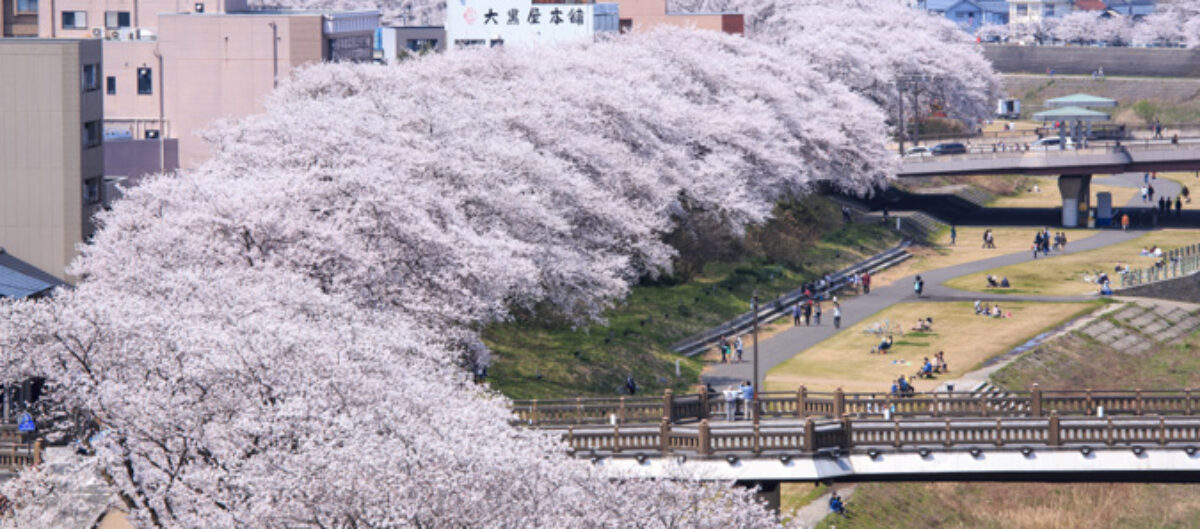
August/1/2020
The Asuwa River (足羽川), which is about 60 kilometers long, is located in Fukui Prefecture, Japan. Mt. Kanmuri (in Ikeda-cho in the prefecture) is the source of the river, which runs through the central part of Fukui.







In my opinion there are three good points about the Asuwa River:
1. Along it there are about 600 cherry blossom trees.
2. There are some unique bridges that span it.
3. It has a fascinating history that’s connected to Fukui.



As I wrote in a previous entry(Cherry Blossoms along the Asuwa River: Asuwa Sakura Tunnel), the bank of the river has been selected as one of Japan’s 100 best spots for viewing cherry blossoms. Every spring a lot of people go there and view them.

There are two unique bridges across the Asuwa River: the Tsukumo Bridge and the Kazura Bridge. The Tsukumo Bridge is near the cherry blossoms I mentioned, and it used to be considered unusual because the northern half was made of wood and the southern half of stone. Hokusai Katsushika, the world-famous Japanese ukiyoe painter, made a painting of the bridge. I’m going to write about that in my next entry.(Tsukumo Bridge used to be unique, and was painted by Hokusai Katsushika.)


The Kazura Bridge is in Ikeda-cho, Fukui Prefecture. It’s a suspension bridge made with natural vines, and it has a total length of 44 meters and a height of 12 meters. There are large gaps between the planks, so it’s thrilling to walk across. People can cross the bridge for a small charge. There’s an English website for Ikeda-cho, and there you can find out where the bridge is located and how you can get to it.( the English webstite for Ikeda-cho is here. )
Shakudani stone is a type of blue-green stone that’s produced in the area of Mt. Asuwa in Fukui. It turns dark blue when it’s wet, so it’s also called Echizen blue stone. It’s been used since the sixth century for coffins, stone monuments, stone Buddhist images, and various daily items. It was especially esteemed in the Edo period, when it was exported throughout Japan as a Fukui specialty. When the stone was transported on ships, the Asuwa River was used.
I went to the river twice to take pictures for my blog. Once when I was there taking pictures I saw about 10 boys playing in the river. They looked very happy, and it was fun to watch them.


Along the river I found some strange white stones. I don’t know why such stones are near the river. Do you?



I used to walk along the Asuwa River to go to work, and I always enjoyed seeing the scenery around it. There are nice sidewalks along the river where a lot of people walk, jog, and cycle.

When I was there recently I went down to the river, and at the bank there were some black mayflies flying around. There were a lot of small stones under my feet. As I got close to the river I heard its sound. I touched the water, and it wasn’t very cold. This might have been my first time to touch the water of the river.
It takes about 15 minutes to get to the Asuwa River from JR Fukui Station. There are a lot of sightseeing spots near the river: Yoroppaken (ヨーロッパ軒)(Sauce katsudon: Fukui’s soul food), Matsuokaken (松岡軒)(Habutae Mochi: a Japanese sweet representative of Fukui with a more than 100-year history), the banks where the cherry blossom trees stand(Cherry Blossoms along the Asuwa River: Asuwa Sakura Tunnel), and the Tsukumo Bridge (九十九橋).
Take a walk along the Asuwa River and see the sights!
